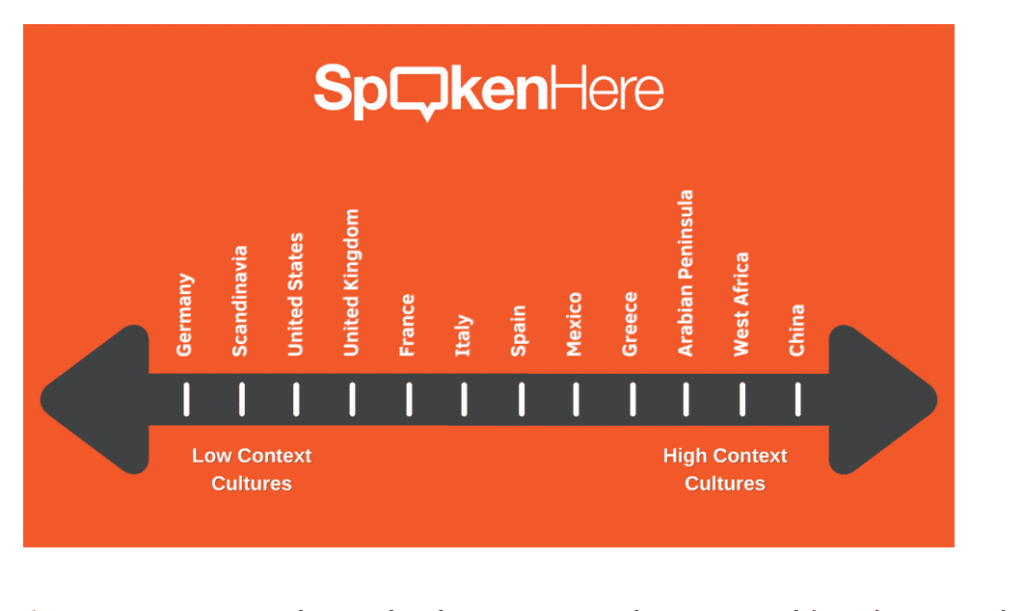
Updated May 14,2024
Is your organization clearly communicating in context?
Join us to examine how important context is to effective intercultural communication and to make sure that your organization is utilizing the best interpretation and translation resources for your audience.
If you’ve ever misunderstood what someone was trying to communicate because of something non-verbal or not explicitly written out that “you should have known,” then you’ve experienced how misunderstood context can quickly derail an interaction.
Communication difficulties in the way two people interpret the context of a conversation can happen in many professional and personal situations. While many factors impact this, we’ve seen challenging intercultural communication issues arise between people whose native languages rely on context to differing degrees.
Maybe, the two communicators even grew up speaking the same language, but their geographical and cultural backgrounds litter their seemingly straightforward communication with contextual differences. Sometimes the results can be catastrophic, while sometimes the blunders result in hilarious stories that might be cringe-worthy, but at least not harmful.
Context in communication matters more than some people acknowledge – to the detriment of their communities and customers.
Meaningful communication relies upon the communicators themselves and/or the supporting interpreters and translators first identifying the importance of context and then harnessing the correct communication tool plus their own expertise to localize all communications. As we often note among our own team, “you need an interpreter for that.”
Let’s take a deeper dive into definitions and resources.
What Do We Mean When We Talk About “Context”?
According to the Oxford Learner’s Dictionary, context is defined as “the situation in which something happens and that helps you to understand it.” What this means in reference to communication is that how we each decode messages based on what our backgrounds are, who we are with, where we are, what is happening around us at the time, our opinions and beliefs, our shared values and experiences, and our non-verbal cues.
Context is hard to explain to others from a different background; however, we use this nuanced “context” to decipher interactions or ideas without being conscious that we’re doing it. If you’re still a little confused about how a difference in cultural contexts can affect communication, here’s an example:
In some cultures, an offer of coffee after a meal is considered a polite way to indicate to guests that they should leave soon. In other cultures, an offer of coffee at a similar social gathering or occasion is viewed as an act of kindness or an invitation to guests to stay longer because everyone is having a great time. If people from different cultural backgrounds (let’s say the host is from Culture “A” and the guests are from Culture “B”) are unaware of these differences, it could easily lead to an awkward situation if coffee is served.

Communication in Context: Explaining High vs. Low “Context” Cultures
The famous anthropologist, Edward T. Hall, studied the effects of context and culture on communication and was the first to discuss the delineations between high context and low context cultures. He noticed that certain cultures relied more on the use of context instead of explicitly stating what was being communicated. He called these high context cultures. In contrast, cultures that tended to communicate using terminology and rules that are explicitly spelled out, he called low context cultures.
High context societies and groups are those where people tend to have close connections over a long period of time. Because of this, certain behaviors and expectations aren’t made explicit, because most members learned what to do and think from years of interactions with each other. When communicating, a person from a high context culture may not verbally state the precise intent of their message, but instead expects the receiver to read between the lines using their contextual understanding. In these cultures, non-verbal contextual cues such as tone of voice, eye contact, gestures, and facial expressions carry a great deal of meaning.
In contrast, among low context societies, behaviors, beliefs, and expectations are more openly spelled out. These cultures rely much less on context to convey meaning and instead state their messages more directly and explicitly. The essence of a communication is conveyed by the precise words used, and there is very little expectation that nonverbal or situational cues might drastically change the meaning.
As you can probably guess, communication between people from high context and low context cultures can be challenging and lead to misunderstandings. People from low context cultures tend to listen primarily to the words spoken and often miss or misinterpret the nuances and non-verbal cues of a high context communicator.
No culture is completely high or low context. However, below is an idea of where some notable cultures fall on the context scale:

As you can see on the scale above, even cultures speaking the same language can rely more or less on context in communicating. That’s why simply understanding or speaking the same language as the person you’re interacting with isn’t always enough to understand their message: there is often contextual meaning buried within the communication.
Communication Tools that Increase Contextual Understanding
Even though two people might speak the same language, being from different countries or cultures impacts how they interpret the words spoken or written. When those two individuals speak, they may easily misinterpret each other.
So, how do you as a friend, organization, employer, health professional, or family member ensure that your meaning does not get lost in translation?
Learn more about what we now know about body language and context? Explore our blog “Is Your Body Language Lost in Translation?” and join in the discussion!
Partnering with an experienced professional interpreter or translator is vital in avoiding some of the breakdowns in understanding what could otherwise occur during intercultural communication. An experienced interpreter or translator will not just have a high-level of sensitivity to cultural context, they will also know which resources to recommend to support meaningful communication in all of the settings that you find yourself in.
Key communication tools and resources include:
Video Remote Interpreting
Video Remote Interpreting (VRI) can provide an easy solution for a company needing to facilitate communication with a limited English proficiency (LEP) person whether they be a customer, employee, member of a multilingual team, patient, or an international client or community partner.
Having a skilled linguistic and cultural liaison present via VRI can be the “deal maker” that helps to solve a problem or to facilitate an agreement across cultural barriers, because it preserves the authenticity of language by showcasing non-verbal cues and other contextual information that would be lost in audio or over-the-phone interpretation (OPI).
Check out our free resource to make the most of communication time: “Top 5 Tips for Optimizing Your Remote Interpreting Session“
Because video remote interpreting sessions do not require the interpreter to be present on-site and yet still retain the authenticity of cultural contexts because of the video platform, companies can simultaneously reduce their personnel costs and still greatly boost participants’ understanding.
Localization
Localization is another key communication resource for those requiring contextually sensitive translation services.
Localization is a step beyond the standard translation project scope or a Google translate response and provides companies with a more accurate end-result that better communicates with the target audience. While localized translations require more time and attention to detail, they are safer, culturally-sensitive, and overall a better representation of what your organization wanted to communicate – whether it be via a localized website translation or any other technical documents and marketing collateral.
Curious if our team of SpokenHere language professionals have experience in localizing translations for your industry? Check out a few of these additional case studies and industry articles for a behind-the-scenes view of our work partnering with clients in the manufacturing industry, healthcare arena, marketing sphere, and non-profit organizational realm (just to name a few! We would love to chat and answer your questions about how our language specialists are ready to meet your business’ communication needs.)
Context Matters to Us Because it Matters to You and Your Communities
When you find yourself in a situation that calls for a skilled linguist and cultural liaison, we’re here to help.
SpokenHere provides on-demand video remote interpreting services with a robust team of skilled, culturally-fluent interpreters. Plus, we understand the complex language service needs of many organizations, and do not require minimum call times or monthly fees from our clients, but rather charge by the minute to make sure companies are confident in both reaching their meaningful communication goals and staying within their budget’s parameters.
We also offer services such as simultaneous interpreting and voiceover support with our team members that specialize in making sure your context is at the forefront of their minds, as they enhance your communication no matter what platform or setting you find yourself in.
SpokenHere’s localization service includes more than rewriting text into a different language, because we focus on adapting your complete message to a specific audience and location. We take a holistic approach, considering other aspects such as adapting graphics, using appropriate date and time formats, and adopting cultural references, among many other details.
We love languages, because we love making sure that people feel seen and are heard, as we actively engage in relationship-building efforts across the globe. Contact us to learn more and view a demonstration.